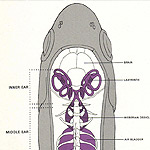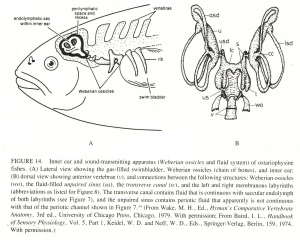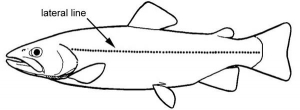Fish hear – Depending on the species they may have any of a number of acoustical adaptations. The practicality of these adaptations can be understood by looking at how the fish reside in their respective habitats. Being gregarious or solitary, predators or prey, nocturnal or diurnal, shallow or deep, near the shore or deep in the ocean, migratory or sedentary – will all have bearing on their acoustical adaptations both in terms of hearing as well as in sound making or “vocalizations.”

Understanding that all life originated in the sea, the biological adaptations of fish have been in the evolutionary mix for quite some time, so what we may consider simple or rudimentary behavioral adaptations may in fact be loaded with subtleties far too fine for us to distinguish. Alternately, relationships may be so well adapted to the surroundings that there is no need for complexity.
Sound in Water and Time
Sound is physical energy induced in a medium as a consequence of some mechanical action imposed in the medium. The energy – called “acoustical energy” is a combination of two characteristics: pressure gradient, and particle motion. The relative intensities of these two characteristics are dependent on the physical characteristics of the medium.
Air is highly compressible so pressure gradient energy is more pronounced in air, and why terrestrial vertebrates have pressure-sensing diaphragms to perceive sound.
What is perhaps ironic is that most hearing studies on fish are focused on pressure sensitivity to frequency and amplitude cues (matching human hearing priorities) whereas fish adaptations may be prioritized around acceleration or velocity sensing (time domain and vector sensing) where amplitude (loudness) is less critical than proximity.
Physical Hearing Adaptations
Sound perception organs in fishes include cilia (nerve hairs), bladders, ossicles, otoliths, accelerometers, and mechanoreceptors in various configurations. Some fish have all of these features, some have only one.
The lateral line along the side of some fishes is comprised of cilia that are akin to the cilia that line the cochlea of the inner ears of terrestrial vertebrates. Some fish don’t have lateral lines, but do have cilia that serve as mechanoreceptors translating acoustically induced particle motion and pressure gradients into the sensory system of the fish.
By way of these two acoustical energy perceptions, the lateral line senses sound and also senses proximity of other moving bodies and thus figures in how fish hold together in their tightly synchronized schools.
Many fish also have gas-filled swim bladders that are used to mediate buoyancy. But as these bladders also represent an acoustical impedance differential in the body (different than the surrounding water and tissues) it can serve as a pressure gradient sensor. In some fishes the swim bladder ties into the inner ‘ears’ of the fish by way of a set of bones similar to our own middle ear bones.
Another hearing organ of fish is an accelerometer set up by dense bones in the skull called otoliths which sense particle motion.
Sound Making Adaptations
Understanding what fish do with their odd and not too varied sound repertoire is mostly a matter of speculation. If sounds are concurrent with breeding displays it can be assumed that there is a correlation to pairing and mating; if territorial encroachment induces sound generation it could be assumed that the sounds are associated with territory advertisement.
Chorusing sounds – done in a group context such as a shoal or a school, would suggest community coherency (the distinction being that a “shoal” of fish hang out together and a “school” of fish swim together).






